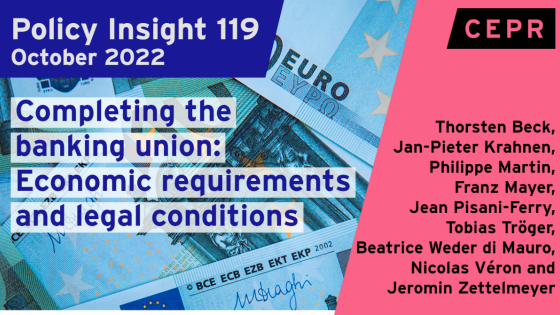In what sense is Banking Union stuck?
Banking Union is based on three major pieces of legislation: the Single Supervisory Mechanism (SSM) Regulation (2013), the Bank Recovery and Resolution Directive (BRRD) (2014), and the Single Resolution Mechanism Regulation (SRMR) that established the Single Resolution Board (SRB) in 2015. The institutions and policy changes were supposed to make banking fragility less likely, permit national bailouts only in exceptional circumstances, and ensure that failed banks could be resolved without fiscal support and without creating a financial disaster. In turn, this was expected to prevent contagion from banks to sovereigns and from sovereigns to banks and facilitate the development of a pan-European banking market and the formation of pan-European banks, thus avoiding the concentration of country-specific risk on the balance sheet of national banks. It was also meant to facilitate bank exit in overbanked economies.
By and large, these aims have not been realised. There have been few bank exits. The euro area banking system remains fragmented along national borders, with very few cross-border mergers and very limited cross-border competition. Banks remain disproportionately exposed to their national sovereigns, and the solutions to banking problems stays predominantly national. In most recorded cases of ailing or failing banks, the SRB-led resolution option has been circumvented, and national practices of dealing with banking crises have continued to diverge significantly.
Proximate causes of the failure
There are four proximate causes. First, significant crisis management competencies remain at the national level. Common supervision and resolution primarily apply to the largest 100-plus banks in the euro area, while national authorities remain responsible for most supervisory tasks in relation to ‘less significant institutions’ (LSIs). Deposit insurance remains national. So is the option to liquidate an ailing bank under normal (national) insolvency procedures, which vary significantly across member states, and allow generous injections of public funds.
Second, supranational decision-making remains fragmented. For example, resolution decisions taken by the SRB may need the consent of other authorities, including DG COMP, the Council, and, at the implementation stage, the input from national resolution authorities (NRAs). This effectively creates numerous veto players and renders efficient decision making difficult, as special interests and their political backers have many places to turn to in their lobbying efforts.
Third, supranational decision makers (the SRB and the European Commission) have both the option and strong incentives to shy away from implementing EU-level resolution. SRB can deny a public interest in resolving a failing bank at the EU level if it determines that resolution objectives can be achieved under normal insolvency proceedings. One incentive to do so is the harsh creditor bail-in regime envisaged by the BRRD, which creates incentives to avoid EU-level resolution in order to allow national bailouts. Another is legal risk: the ‘no creditor worse off’ (NCWO) principle, enshrined in SRMR and BRRD, requires resolution authorities to pick resolution schemes and actions that do not impose greater losses on bailed-in creditors than these would have incurred in national insolvency proceedings.
Fourth, attempts to enact regulation that would limit the exposures of banks to the domestic sovereign, such as concentration limits, have not been successful.
Underlying causes: National government finances and self-perpetuating fragmentation
Banking Union has not lived up to expectations in part because its regulatory and institutional architecture is still not powerful enough to offset a national bias that dominates banking sector policy: the desire of most member states to maintain control over their banking systems. This reflects two main underlying causes.
First, fiscal decisions remain largely in the hands of national policymakers that are accountable to domestic electorates. Government finance and banks are in turn closely linked – via the fiscal liabilities generated by banking crises, but also because domestic banking systems can be asked to provide government financing in times of stress.
Second, national concerns are to some extent self-perpetuating. A major reason for the dominance of national concerns in banking markets is the limited regional market coverage of their business, which for most banks is the national market, or a fraction thereof. National concerns in turn perpetuate national markets, by limiting the cross-border flow of liquidity in times of crises and protecting national or regional banks against foreign competitors.
Reform: Three levels of ambition
An incremental deal
This would improve the crisis management and deposit insurance framework while not attempting, at this stage, to further reduce the bank-sovereign vicious circle: (1) extend the EU-level crisis management framework to small and medium-sized banks; (2) tighten state aid rules to reduce possibilities for bailouts via national insolvency procedures; (3) provide the SRB with autonomous data access rights; (4) disclose key raw data to the public; (5) treat small banks that coordinate through institutional protection schemes like single bank holding companies; and (6) enact regulation, including the principle that all deposits other than senior non-preferred debt rank equally, to make it less likely that bail-ins impose losses on uninsured deposits and other ‘runnable’ short-term funding source of banks.
A real deal
This would break the bank-sovereign vicious circle, without necessarily eliminating all national idiosyncrasies that contribute to the fragmentation of European banking markets: (1) consolidate crisis management decision-making under a single European resolution agency, the SRB, thus integrating all national relevant entities, and merge the existing deposit guarantee systems into the SRB to create a single, FDIC-like institution; (2) create a common financial backstop for the expanded SRB, possibly relying on the ESM; (3) include sovereign concentration charges for bond holdings at the bank level, with prudent calibration and transitional arrangements in the EU Single Rulebook; and (4) create a genuinely two-tier European mandatory deposit guarantee scheme, with a waterfall of loss-absorption, starting at the national level, also integrating institutional protection schemes.
A cosmic deal
This would lead to full market integration, which we view as desirable but much more distant and long-term. A truly single market would enable easy cross-border provision of financial services within the euro area. It would need: (1) a single system of bank taxation; (2) a single system for corporate and personal insolvency; and (3) a single framework for housing finance and mortgages. While radical, these reforms may not require treaty change.
Conclusion
Despite considerable progress as far as the loss-absorption capacity of individual banks is concerned, Europe’s banking system is still mostly national in reach and coverage, representing a concentration risk at the national level that continues to suppress the level of market discipline required for resilience in banking. The aspiration of the next round of regulatory evolution varies from a low ‘incremental’ all the way up to a ‘cosmic’. In our view, policymakers should at a minimum aim for the ‘real deal’, involving (1) a super-SRB that both fully integrates national resolution bodies and national deposit insurance schemes, possibly in a two-tier design; and (2) concentration limits for sovereign bond holdings by banks, thereby discouraging government bailout of banks and weakening the bank-state nexus.
References
Beck, T (2012), Banking Union for Europe – Risks and Challenges, CEPR Press.
Beck, T, J-P Krahnen, P Martin, F Mayer, J Pisani-Ferry, L Reichlin, T Tröger, B Weder di Mauro, N Véron and J Zettelmeyer (2022), “Completing the banking union: Economic requirements and legal conditions”, CEPR Policy Insight No. 119.
Schnabel, I and N Véron (2018), “Completing Europe’s Banking Union means breaking the bank-sovereign vicious circle”, VoxEU.org, 16 May.











